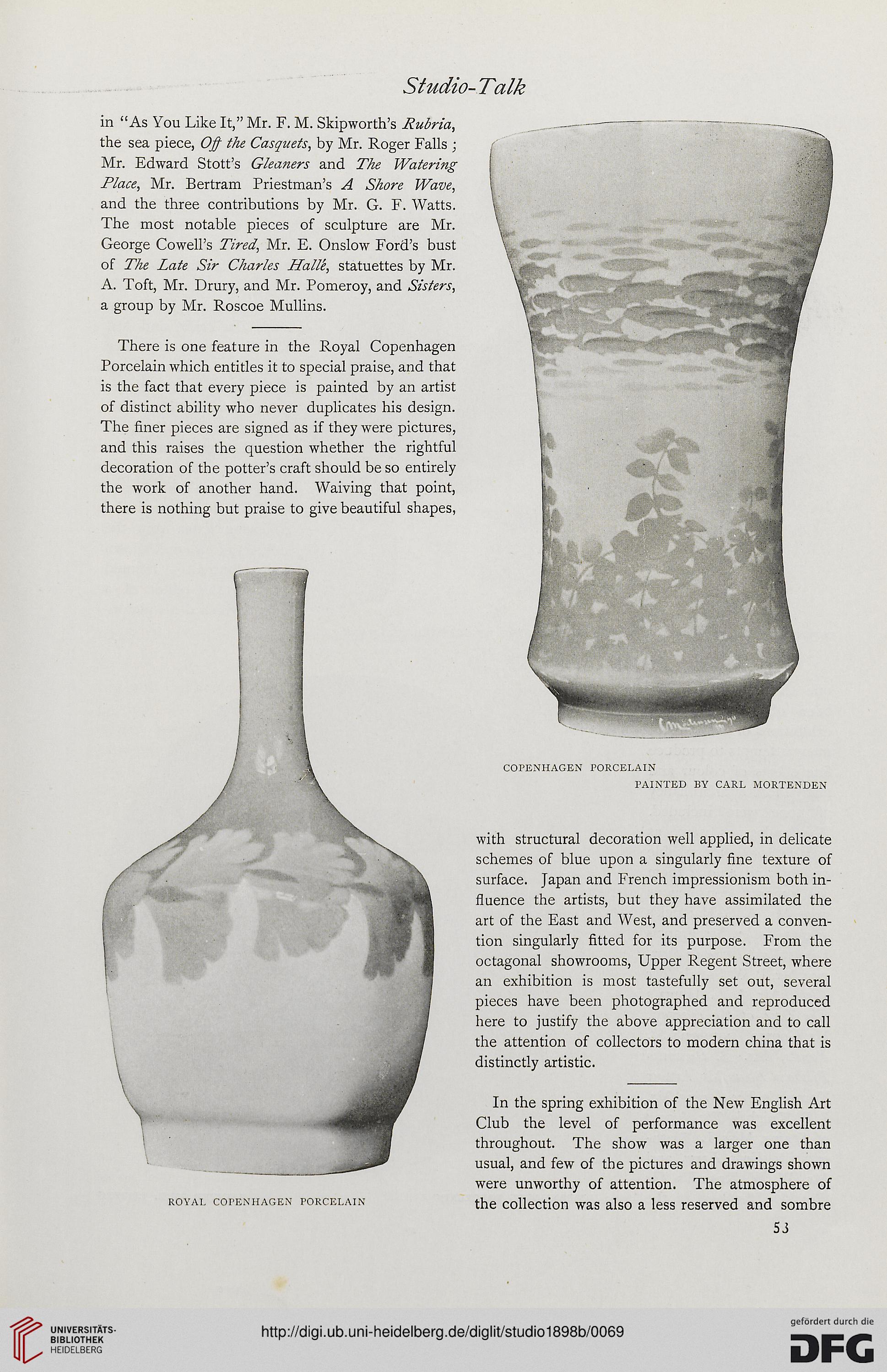Studio-Talk
in “As You Like It,” Mr. F. M. Skipworth’s Rubria,
the sea piece, Off the Casquets, by Mr. Roger Falls ;
Mr. Edward Stott’s Gleaners and The Watering
Place, Mr. Bertram Priestman’s A Shore Wave,
and the three contributions by Mr. G. F. Watts.
The most notable pieces of sculpture are Mr.
George Cowell’s Tired, Mr. E. Onslow Ford’s bust
of The Late Sir Charles Halle, statuettes by Mr.
A. Toft, Mr. Drury, and Mr. Pomeroy, and Sisters,
a group by Mr. Roscoe Mullins.
There is one feature in the Royal Copenhagen
Porcelain which entitles it to special praise, and that
is the fact that every piece is painted by an artist
of distinct ability who never duplicates his design.
The finer pieces are signed as if they were pictures,
and this raises the question whether the rightful
decoration of the potter’s craft should be so entirely
the work of another hand. Waiving that point,
there is nothing but praise to give beautiful shapes,
COPENHAGEN PORCELAIN
PAINTED BY CARL MORTENDEN
with structural decoration well applied, in delicate
schemes of blue upon a singularly fine texture of
surface. Japan and French impressionism both in-
fluence the artists, but they have assimilated the
art of the East and West, and preserved a conven-
tion singularly fitted for its purpose. From the
octagonal showrooms, Upper Regent Street, where
an exhibition is most tastefully set out, several
pieces have been photographed and reproduced
here to justify the above appreciation and to call
the attention of collectors to modern china that is
distinctly artistic.
In the spring exhibition of the New English Art
Club the level of performance was excellent
throughout. The show was a larger one than
usual, and few of the pictures and drawings shown
were unworthy of attention. The atmosphere of
royal Copenhagen porcelain the collection was also a less reserved and sombre
S3
in “As You Like It,” Mr. F. M. Skipworth’s Rubria,
the sea piece, Off the Casquets, by Mr. Roger Falls ;
Mr. Edward Stott’s Gleaners and The Watering
Place, Mr. Bertram Priestman’s A Shore Wave,
and the three contributions by Mr. G. F. Watts.
The most notable pieces of sculpture are Mr.
George Cowell’s Tired, Mr. E. Onslow Ford’s bust
of The Late Sir Charles Halle, statuettes by Mr.
A. Toft, Mr. Drury, and Mr. Pomeroy, and Sisters,
a group by Mr. Roscoe Mullins.
There is one feature in the Royal Copenhagen
Porcelain which entitles it to special praise, and that
is the fact that every piece is painted by an artist
of distinct ability who never duplicates his design.
The finer pieces are signed as if they were pictures,
and this raises the question whether the rightful
decoration of the potter’s craft should be so entirely
the work of another hand. Waiving that point,
there is nothing but praise to give beautiful shapes,
COPENHAGEN PORCELAIN
PAINTED BY CARL MORTENDEN
with structural decoration well applied, in delicate
schemes of blue upon a singularly fine texture of
surface. Japan and French impressionism both in-
fluence the artists, but they have assimilated the
art of the East and West, and preserved a conven-
tion singularly fitted for its purpose. From the
octagonal showrooms, Upper Regent Street, where
an exhibition is most tastefully set out, several
pieces have been photographed and reproduced
here to justify the above appreciation and to call
the attention of collectors to modern china that is
distinctly artistic.
In the spring exhibition of the New English Art
Club the level of performance was excellent
throughout. The show was a larger one than
usual, and few of the pictures and drawings shown
were unworthy of attention. The atmosphere of
royal Copenhagen porcelain the collection was also a less reserved and sombre
S3




